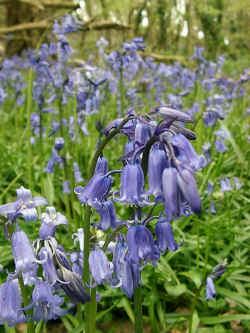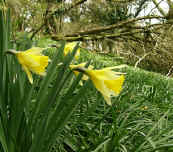Ancient Woodland Indicator Species

Lists of plant species which favour ancient woodland sites in particular geographical areas of Britain have been compiled by ecologists. By assessing the number of these species present in a particular wood, an educated guess can be made as to whether it is an ancient woodland site or not. Indicator species are useful tools, but the lists need to be used with caution and only those applicable to a particular area should be used in that area.
| Certain woodlands can credibly be established as being
'ancient' through the study of old historical records such as
maps and estate records. Observations of landscape features such as banks, ditches and
other topographical features within a wood will also give clues to previous land use. By
surveying a number of these 'proven' ancient woodlands, species which are usually confined
to this type of habitat can be identified. Their presence can then be used to indicate
ancient woodland status in other less well-documented woodlands. The indicator species
chosen are commonly plants rather than animals. This is because plants are usually
conspicuous, relatively easy to identify and do not hide or absent themselves when humans
are present! Most Ancient Woodland Indicator Species lists are based on vascular plants (flowering plants, native conifers and ferns). These species are known as Ancient Woodland Vascular Plants (AWVP). AWVP scores (the number of these species present at a particular site) are frequently considered in conservation work. Indicator species lists have also been constructed for some areas using Bryophytes (mosses) and epiphytic lichens (those which grow on trees). These lists of species provide extremely useful tools for ecologists and conservationists in evaluating woodland habitats. However, they do need to be used with a degree of caution. Lists of indicator species will vary according to geographical location. This means that lists specifically worked out for a geographical area, such as the Southwest of England, must be consulted if one is surveying in Devon. A list compiled in Lincolnshire, for example, may give completely erroneous results in other areas of the country. This is because local geology, soils, climate and history of land use will all influence the plant species present and their ecological distribution. For example, Hay-scented Buckler Fern, which is restricted to woodland in certain areas, is much more common and widespread in mild, wet southwestern counties. It is therefore of less use as an indicator in these regions. In addition, the presence of a few relevant indicator species does not mean that a woodland should be designated as 'ancient'. In general, the greater the number of Ancient Woodland Indicator species occurring together in a wood, the greater the probability that a woodland can be accorded this status. Below a certain minimum number of species, few conclusions can be drawn.
Examples of AWVP species
Continue to Woodland Management
Sources of Information: Francis Rose (1999) Indicators of ancient woodland - the use of vascular plants in evaluating ancient woods for nature conservation. British Wildlife: 10 (4) 241 - 251 George Peterken (2000) Identifying ancient woodland using vascular plant indicators. British Wildlife: 11 (3) 153 - 158
|
||||||||||||

